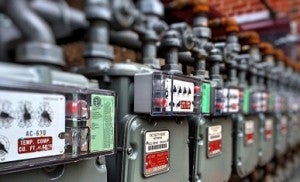 We all know exercise is good for our hearts and bodies, and who doesn’t enjoy stepping on the scale after weeks of good workouts to confirm progress was made?
We all know exercise is good for our hearts and bodies, and who doesn’t enjoy stepping on the scale after weeks of good workouts to confirm progress was made?
In a way, power companies are just like people.
As they begin to invest in smart meters and other grid modernization efforts, utilities want to know how well they do. Are grid programs fulfilling environmental promises and cutting pollution? Can they measure success and prove to investors and regulators they’re making smart decisions?
To that effect, Illinois’ largest electricity provider, Commonwealth Edison, is the first in the country to adopt a new tool that calculates clean air benefits from investments such as advanced meters.
Beyond bringing tangible rewards to ComEd, this little-noticed milestone can have major implications for the entire power industry.
$2.6 billion for smart grid paved way
After Illinois passed the Energy Infrastructure Modernization Act in 2011, channeling $2.6 billion to ComEd to modernize the grid, the company began to replace customers’ conventional electric meters with advanced meters. The new devices make it easier to provide energy savings programs and other clean energy services, while helping the utility reduce outages.
The company is now more than half-way there, having deployed more than 2 million meters across its territory, along with other sensing and control technology.
This is where the first-of-its kind metric comes in.
ComEd started to use the measurement tool earlier this year to calculate and report greenhouse gas reductions to state regulators from its new and advanced energy infrastructure. It was developed in collaboration with Environmental Defense Fund and the Citizens Utility Board, Illinois’ premiere utility watchdog.
The initiative serves, in essence, as a pilot project for other power companies that share ComEd’s objectives to build a modern grid and be held accountable to investors and the public they serve.
[Tweet “New tool measures smart grid benefits. A game changer for our power industry?”]
This metric…does what, exactly?
By determining the carbon value of a kilowatt-hour of electricity for all 8,760 hours in a single year, the new metric can pinpoint how much pollution the advanced meters are keeping out of the air.
For example, when power comes from high-carbon coal, using a kWh of this electricity results in more carbon pollution than when power is coming from mostly low-carbon wind or solar.
Advanced meters can also open the door for numerous clean energy and smart grid tools, such as energy efficiency and demand response, which rewards customers for conserving electricity when the grid needs it most. The metric will be able to track the greenhouse gas reductions associated with all of these efforts, and more.
Rewards too good to pass up
As ComEd continues its advanced meter rollout, the utility hopes to be rewarded accordingly. Illinois offers higher earnings for utilities that show they’re meeting the goals of the state’s grid modernization plan.
As the company gains more experience with the metric’s use, it will also be able to incorporate the findings into future plans and make more informed investment decisions going forward.
ComEd may be first out of the gate with this innovative tool, but it probably won’t be the last in our growing clean energy economy.









